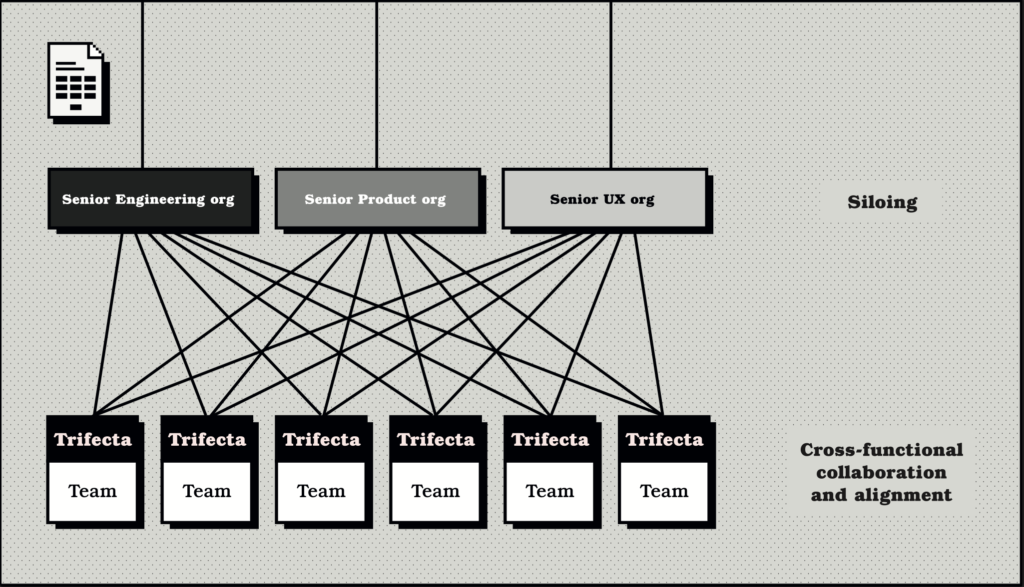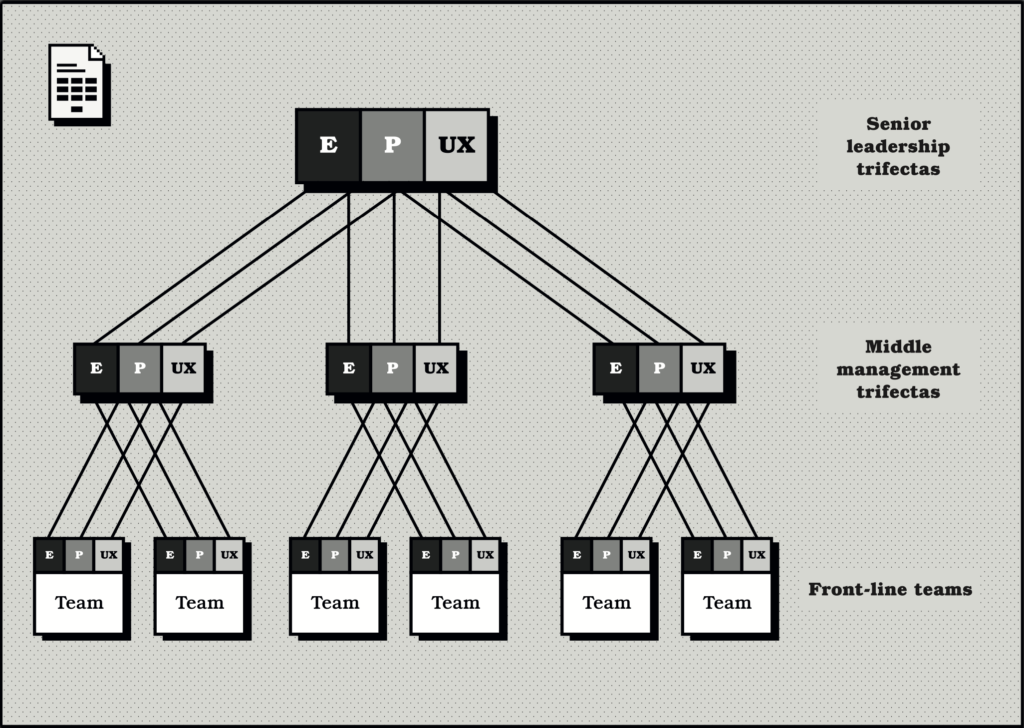One of the most powerful groups that you can be part of as a senior leader is a trifecta. A trifecta is a group of three people from different disciplines who work together to achieve a goal. Typically, this is a group consisting of engineering, product, and UX.
- Engineering is responsible for building the product, that is, writing the lines of code that make it work.
- Product is responsible for defining what the product should do, that is, what features it should have and how it allows a user to achieve their goals.
- UX is responsible for designing how the product should work, that is, how the user interacts with it and how it looks.
With these three disciplines working together, you have a powerful combination of skills and perspectives that can create a product that is scalable, useful, and beautiful.
We often think of trifectas as being an artifact of a single front-line team, rather than anything to do with senior management. For example, a team may have a product manager, a UX designer and a number of engineers that report to a single engineering manager. The three disciplines work together to define, design, and build the product, and in doing so, they experience positive tension that helps them to make better decisions.
For example, some of these trade-offs can be:
- Scope versus effort. Engineering might emphasize building robust, extensible solutions, while Product might prioritize faster delivery to validate a hypothesis of product-market fit first. The right balance will be up for debate.
- User needs versus technical constraints. Product or UX may advocate for a feature that is simple to use but highly challenging to implement, while engineering may advocate for a simpler solution that is easier to build and maintain with a less optimal user experience.
- User education versus product simplicity. Product may advocate for a feature that is complex and customizable but powerful, while UX may advocate for a simpler solution that is easier to understand and use by the majority of users.
These trade-offs and debates are not bad: they are in fact extremely healthy. They force the team to make better decisions and in doing so, they create a better product.
In terms of their responsibilities, a team’s trifecta will:
- Ensure strategic alignment. The trifecta will work together to ensure that the team’s work is aligned with the wider organization’s strategy. They will also ensure that the team’s work is aligned with the work of other teams, identifying and resolving gaps or overlaps.
- Define the team’s roadmap. The trifecta will facilitate the idea generation process, and then work together to define the team’s roadmap. This includes getting the right balance between new features, technical debt, UX improvements, and other work.
- Make decisions. The quality of the work outlined in the bullet points above is dependent on the quality of the decisions that the trifecta makes. Daily, weekly, monthly, and quarterly, the trifecta will make decisions about what needs prioritizing, what needs to be cut, and what needs to be changed.
- Drive up the execution of their individual crafts. Achieving excellence in engineering, product, and UX does not happen by accident. It requires a concerted effort to ensure that the team is constantly improving in each of these areas in balance with delivering the roadmap, and each member of the trifecta will represent their craft. For example, the engineering lead will have an eye for scalability, resilience, and performance, while the UX lead will have an eye for usability, accessibility, and aesthetics.
- Resolve escalations and blockers. The trifecta will be the first port of call for any escalations or blockers that the team encounters. They will work together to resolve these issues, and if they can’t, they will escalate to the next level of management.
- Communicate with stakeholders. The trifecta is responsible for communicating with stakeholders, including other teams, senior management, external partners and users, and other parts of the organization. They will work together to ensure that the right information is communicated to the right people at the right time.
However, there is something important you need to consider as a senior leader: even if you have clearly defined trifectas for each of your teams, a critical bug that creeps into organizations is that healthy, collaborative trifectas are only found within the front-line teams and nowhere else. This is a problem, but you can fix it.
Lack of Trifectas = Increase in Siloing
In many organizations, as you progress up the org chart, trifectas, along with their benefits, disappear.
This happens because typically organizations form their reporting lines around each discipline: engineering managers report into Directors of Engineering, VPs of Engineering and beyond, and the same is true for Product and UX. Now, it’s worth stating that there is nothing wrong with this at all. In fact, it’s a great way of ensuring that each discipline has a clear career path, and that each discipline has a clear voice at the senior levels of the organization.
However, it does mean that the trifecta structure and the positive tension that it brings can be lost, and senior leaders become isolated from all of the benefits of cross-functional collaboration. At best, this is a missed opportunity. At worst, it can lead to a dysfunctional organization.
Looking at the following diagram, we can see what happens when trifectas are only found within the front-line teams. Where they exist, we get the cross-functional collaboration that we want, but as we move up the org chart, we lose it.

The result is that the senior leaders are isolated from each other as part of warring factions, leading to dysfunctional behavior such as:
- Lack of visibility. Senior leaders only view the world through the lens of their own discipline. They are not exposed to the perspectives of other disciplines, and as a result struggle to make decisions in the same unified way that the front-line trifectas do.
- Lack of alignment. The lack of visibility leads to a lack of alignment between the different disciplines because they are not jointly accountable as part of a trifecta. For example, senior engineering leaders may only hear that not enough technical debt is being paid down, leading to a myopic, unbalanced view of the work that is being done. This leads to increased tension and conflict between the disciplines as a whole.
- Lack of accountability. While each trifecta-led team is wholly accountable for the work that they do and managing the trade-offs between the disciplines, the senior leaders are not: they are only accountable for their own discipline. This makes it far harder to make decisions that span the org chart: it can feel like an adversarial situation where each discipline is trying to get the best deal for themselves. This is not the behavior of senior role models: they should unite rather than divide.
- Lack of escalation paths. When a trifecta-led team encounters an escalation or blocker that they cannot resolve themselves, they need a route to escalate it to the next level of management. However, if the next level of management is not part of a trifecta, then the escalation path is unclear.
As such, it is in your best interest to ensure that trifectas are present among the senior leadership team and middle management in the same way that they are present in the front-line teams. Not only does this work against the above problems, it also helps to ensure that the senior leadership team is unified behind a common goal and that they are able to make decisions that are aligned with the long-term strategy of the organization, not just their own discipline.
The following diagram shows what this might look like. In it we can see that the trifectas are present at all levels of the org chart. Every front-line team ladders up to a more senior trifecta, and these in turn ladder up to trifectas at the executive level. This means that the trifecta structure is present everywhere, and that the benefits of cross-functional collaboration are present everywhere too.

It is worth mentioning that this trifecta organizational structure is not the same as reporting lines. Therefore, it doesn’t matter if the reporting lines of senior managers line up directly with the trifecta ownership structure. What matters is that the trifectas are defined, present, and accountable for the areas that they oversee.
For example, if a large technology company develops multiple products, each with tens of front-line teams, then you would expect to see a trifecta for each of those products that those teams work on, with all of the front-line teams laddering up to those senior trifectas. Above them would be the most senior trifecta, which would be responsible for the entire product portfolio.
There are many benefits to having trifectas all the way up the org chart:
- Accountability is clear. Each trifecta is accountable for the work that they oversee, and each piece of accountable work has a clear cross-disciplinary group of owners. They vouch for the product and the company first, not their own discipline.
- Positive tension is present at all levels. Each trifecta is responsible for managing the trade-offs between the disciplines, and this positive tension is present at all levels of the org chart. This means that the decisions that are made are more likely to be balanced and well-considered in the same way that they are in the front-line teams.
- Escalations are resolved quickly. If a front-line team encounters an escalation or blocker that they cannot resolve themselves, they can escalate it to the trifecta that they ladder up to. If that trifecta cannot resolve it, they can escalate it further, and so on, until it reaches a trifecta that have the accountability and authority to resolve it.
- The trifecta structure maps neatly to the roadmap and project approvals. It is a natural fit for this process. Every trifecta will own their own piece of the roadmap, and senior trifectas own the roadmap for broad areas. Overlaying the escalation process on top of this means that the trifecta structure is also a natural fit for project approvals, resourcing debates, and other prioritization discussions.
Ensuring that you have trifectas all the way up the org chart is one of the simplest and most effective ways of raising accountability, improving decision-making, and ensuring that everyone is unified around a common goal while vouching for their own disciplines in a way that is healthy, constructive, and filled with positive tension.